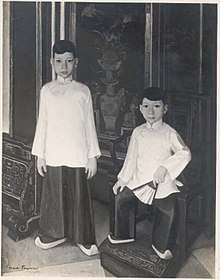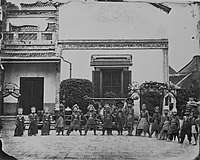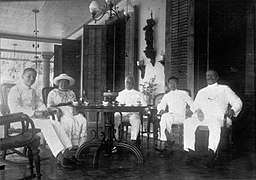Cabang Atas

The Cabang Atas — literally 'highest branch' in Malay — was the traditional Chinese establishment or gentry of colonial Indonesia.[1][2] As a privileged social class, they exerted a powerful influence on the political, economic and social life of pre-revolutionary Indonesia, in particular on its local Chinese community.[1][2]
Origin of term
The phrase 'Cabang Atas' was first used by the colonial Indonesian historian Liem Thian Joe in his book Riwajat Semarang (published in 1933).[1] The term refers to a small group of old gentry families that dominated the Dutch colonial institution of the Chinese officership (see 'Kapitan Cina'); this was colonial Indonesia's equivalent of the Chinese mandarinate.[3][1][2] As a class, they intermarried to maintain their political and economic power, owned extensive agricultural landholdings and monopolised the colonial government's lucrative revenue farms.[1][4]
In older literature, the Cabang Atas is also referred to as the baba bangsawan (Malay for 'Chinese gentry').[3]
History
Origin
As a class, the oldest families of the Cabang Atas traced their roots in Indonesia back to early Chinese allies of the Dutch East India Company, many of whom — such as Souw Beng Kong, first Kapitein der Chinezen of Batavia (1580-1644); or the sons of Han Siong Kong (1673-1743), founder of the Han family of Lasem — played an instrumental role in establishing Dutch colonial rule in Indonesia in the seventeenth and eighteenth centuries.[5] Some families came of gentry stock in China, but many more started off as successful merchant families.[6][4] They shared some common traits with the scholar-gentry of Imperial China, but accumulated much greater dynastic wealth thanks partly to the protection of Dutch colonial law.[7][8]
The foundation of their political power was their near-hereditary control of the bureaucratic posts of Majoor, Kapitein and Luitenant der Chinezen.[7][2] This gave them a high degree of political and legal jurisdiction over the local Chinese community. By colonial Indonesian tradition, descendants of Chinese officers bore the hereditary title Sia.[3]
In addition, most families of the Cabang Atas owned particuliere landrijen or private domains in the Ommelanden (rural hinterland) of Batavia (now Jakarta); or appanage leaseholds in the Javanese princely states.[5][8] This gave them significant seigniorial powers over the indigenous peasants living on their landholdings, but also earned them much enmity and resentment.[5][8]
The economic foundation of the Cabang Atas, as pointed out by the American historian James R. Rush, was their monopolistic control of the colonial government's revenue farms, in particular the highly lucrative opium farms.[2] These farms were auctioned off with much fanfare and ceremony at the local colonial administrator's residence to the highest bidders, and were most frequently won by members of the Cabang Atas or others allied to, or backed, by them.[2] Menghong Chen highlights, however, that among some more established Cabang Atas families, commercial activities as represented by the revenue farms were looked down upon, hence a gradual shift towards landownership and agriculture.[9] In any case, the accumulation of great fortunes among Cabang Atas families received the protection of Dutch colonial law.[10] This legal certainty gave a firm basis to the creation of long-lasting bureaucratic and landowning dynasties of great wealth in colonial Indonesia that were not as common in pre-revolutionary China.[8]
Ethnically and culturally, families of the Cabang Atas were overwhelmingly creolised 'Peranakan Chinese'.[2][4] There was extensive intermarriage between Cabang Atas families in order to consolidate their political power and influence, as well as estates and fortunes.[2][4] Social mobility, however, was possible; Cabang Atas families sometimes took in successful totok, or newly arrived, settlers as sons-in-law.[11][12][4] As cited by the historian Ong Hok Ham, notable examples included the late nineteenth-century, totok businessman Oei Tjie Sien (1835–1900), who married a middle-class Peranakan woman; and the latter's Peranakan son Oei Tiong Ham, Majoor der Chinezen (1866–1924), who firmly sealed the family's social ascent by marrying into the Cabang Atas and by his eventual elevation to the Chinese officership.[12]
Modern history
_with_baby.jpg)
In the early twentieth century, in keeping with their so-called 'Ethical Policy', the Dutch colonial authorities made a concerted effort to appoint government officials, including Chinese officers, based on merit rather than family background.[7] Some of these candidates came from outside traditional Cabang Atas families, including totok appointees, such as Tjong A Fie, Majoor der Chinezen (1860–1921) in Medan and Lie Hin Liam, Luitenant der Chinezen in Tangerang and Khoe A Fan, Luitenant der Chinezen in Batavia.[13][7][14]
Due to their close proximity to Dutch colonial authorities, many families of the Cabang Atas adopted the Dutch language and many European cultural norms.[15] European education and westernisation among the Cabang Atas began in the second half of the nineteenth century, and became the norm by the beginning of the twentieth century.[16] Their close identification with Dutch power meant that their privileged position was attacked during the Indonesian Revolution.[15][5] The end of Dutch colonial rule in 1950 saw the emigration of many families of the Cabang Atas, and the end of their dominating position in Indonesian political, economic and social life.[15][5][12]
See also
- Kapitan Cina: the political institution dominated by families of the Cabang Atas in colonial Indonesia.
- Scholar-gentry and Landed gentry in China.
References
- 1 2 3 4 5 Liem, Thian Joe (2004). Riwayat Semarang (in Indonesian). Jakarta: Hasta Wahana. ISBN 9789799695215. Retrieved 23 February 2018.
- 1 2 3 4 5 6 7 8 Rush, James R. (2007). Opium to Java: Revenue Farming and Chinese Enterprise in Colonial Indonesia, 1860-1910. Singapore: Equinox Publishing. ISBN 9789793780498. Retrieved 23 February 2018.
- 1 2 3 Blussé, Leonard; Chen, Menghong (2003). The Archives of the Kong Koan of Batavia. BRILL. ISBN 9004131574.
- 1 2 3 4 5 Haryono, Steve (2017). Perkawinan Strategis: Hubungan Keluarga Antara Opsir-opsir Tionghoa Dan 'Cabang Atas' Di Jawa Pada Abad Ke-19 Dan 20. Rotterdam: Steve Haryono. ISBN 9789090302492. Retrieved 25 June 2018.
- 1 2 3 4 5 Lombard-Salmon, Claudine (1991). "The Han Family of East Java. Entrepreneurship and Politics (18th-19th Centuries)". Archipel (in French). 41 (1): 53–87. doi:10.3406/arch.1991.2711. Retrieved 23 February 2018.
- ↑ Lombard-Salmon, Claudine (1997). "La communauté chinoise de Surabaya. Essai d'histoire, des origines à la crise de 1930". Archipel (in French). 53 (1): 121–206. doi:10.3406/arch.1997.3396. Retrieved 23 February 2018.
- 1 2 3 4 Lohanda, Mona (1996). The Kapitan Cina of Batavia, 1837-1942: A History of Chinese Establishment in Colonial Society. Jakarta: Djambatan. ISBN 9789794282571. Retrieved 23 February 2018.
- 1 2 3 4 Osterhammel, Jürgen (2014). The Transformation of the World: A Global History of the Nineteenth Century. New Jersey: Princeton University Press. ISBN 9781400849949. Retrieved 23 February 2018.
- ↑ Chen, Menghong (2011). De Chinese gemeenschap van Batavia, 1843-1865: een onderzoek naar het Kong Koan-archief (in Dutch). Amsterdam University Press. ISBN 9789087281335. Retrieved 9 April 2018.
- ↑ Blussé, Leonard (1985). Strange company: Chinese settlers, mestizo women and the Dutch in Voc Batavia.
- ↑ Schrader, Heiko (1997). Changing Financial Landscapes in India and Indonesia: Sociological Aspects of Monetization and Market Integration. Münster: LIT Verlag Münster. ISBN 9783825826413.
- 1 2 3 Ong, Hok Ham (2003). Power, Politics, and Culture in Colonial Java. Metafor Pub. ISBN 9789793019116. Retrieved 23 February 2018.
- ↑ Williams, Lea E.; Studies, Massachusetts Institute of Technology Center for International (1960). Overseas Chinese nationalism: the genesis of the Pan-Chinese movement in Indonesia, 1900-1916. Massachusetts: Free Press. Retrieved 20 April 2018.
- ↑ Suryadinata, Leo (2015). Prominent Indonesian Chinese: Biographical Sketches (4th edition). Institute of Southeast Asian Studies. ISBN 9789814620505. Retrieved 9 April 2018.
- 1 2 3 Yoshihara, Kunio (1989). Oei Tiong Ham Concern: the first business empire of Southeast Asia. Kyoto: Center for Southeast Asian Studies, Kyoto University. Retrieved 23 February 2018.
- ↑ Govaars-Tjia, Ming Tien Nio (2005). Dutch colonial education: the Chinese experience in Indonesia, 1900-1942. Chinese Heritage Centre. ISBN 9789810548605.


